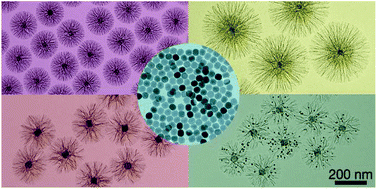Our official English website, www.x-mol.net, welcomes your feedback! (Note: you will need to create a separate account there.)
Engineering of monodisperse core-shell up-conversion dendritic mesoporous silica nanocomposites with a tunable pore size.
Nanoscale ( IF 5.8 ) Pub Date : 2020-02-18 , DOI: 10.1039/c9nr10813k Yu Dai 1 , Dongpeng Yang 1 , Danping Yu 2 , Songhai Xie 1 , Biwei Wang 1 , Juan Bu 1 , Bin Shen 1 , Wei Feng 1 , Fuyou Li 1
Nanoscale ( IF 5.8 ) Pub Date : 2020-02-18 , DOI: 10.1039/c9nr10813k Yu Dai 1 , Dongpeng Yang 1 , Danping Yu 2 , Songhai Xie 1 , Biwei Wang 1 , Juan Bu 1 , Bin Shen 1 , Wei Feng 1 , Fuyou Li 1
Affiliation

|
Fabricating lanthanide doped up-conversion luminescence based nanocomposites has drawn increasing attention in nanoscience and nanotechnology. Although challenging in precise synthesis, structure manipulation and interfacial engineering, fabricating dendritic mesoporous silica coated up-conversion nanoparticles (UCNP@dMSNs) with a tunable pore size is of great importance for the functionalization and application of UCNPs. Herein, we report a strategy to prepare uniform monodisperse UCNP@dMSNs with a core-shell structure. The silica shell has tunable center-radial and dendritic mesoporous channels. The synthesis was carried out in the heterogeneous oil-water microemulsion phase of the Winsor III system reaction system, which allows silica to be deposited directly on hydrophobic UCNPs through the self-anchoring of micelle complexes on the oleic acid ligand. The average pore size of UCNP@dMSNs could be tailored from ∼10 to ∼35 nm according to the varied amounts of co-solvent in the mixture. The microemulsion approach could also be used to prepare hierarchical UCNP@dMSNs with a multi-generational mesostructure. The resultant UCNP@dMSNs exhibit the unique advantage of loading "guest" nanoparticles in a self-absorption manner. We proved that Cu1.8S NPs (∼10 nm), Au NPs (∼10 nm) and Fe3O4 NPs (∼25 nm) could be incorporated in UCNP@dMSNs, which in turn validates the high adsorption capacity of UCNP@dMSNs.
中文翻译:

具有可调节孔径的单分散核-壳上转换树状中孔二氧化硅纳米复合材料的工程。
基于镧系元素掺杂的上转换发光的纳米复合材料在纳米科学和纳米技术中引起了越来越多的关注。尽管在精确合成,结构操纵和界面工程方面具有挑战性,但制造具有可调孔径的树枝状介孔二氧化硅涂层的上转换纳米粒子(UCNP @ dMSNs)对于UCNP的功能化和应用至关重要。在本文中,我们报告了一种制备具有核-壳结构的均匀单分散UCNP @ dMSNs的策略。二氧化硅壳具有可调节的中心径向和树状介孔通道。合成是在Winsor III系统反应体系的非均相油水微乳液相中进行的,这使得二氧化硅可以通过油酸配体上的胶束复合物的自锚定直接沉积在疏水性UCNP上。UCNP @ dMSNs的平均孔径可根据混合物中助溶剂的变化量在约10至约35 nm之间调整。微乳液方法也可用于制备具有多代介观结构的分级UCNP @ dMSN。所得的UCNP @ dMSNs具有以自吸收方式加载“来宾”纳米颗粒的独特优势。我们证明了UCNP @ dMSNs中可以掺入Cu1.8S NPs(〜10 nm),Au NPs(〜10 nm)和Fe3O4 NPs(〜25 nm),从而验证了UCNP @ dMSNs的高吸附能力。微乳液方法也可用于制备具有多代介观结构的分级UCNP @ dMSN。所得的UCNP @ dMSNs具有以自吸收方式加载“来宾”纳米颗粒的独特优势。我们证明了UCNP @ dMSNs中可以掺入Cu1.8S NPs(〜10 nm),Au NPs(〜10 nm)和Fe3O4 NPs(〜25 nm),从而验证了UCNP @ dMSNs的高吸附能力。微乳液方法也可用于制备具有多代介观结构的分级UCNP @ dMSN。所得的UCNP @ dMSNs具有以自吸收方式加载“来宾”纳米颗粒的独特优势。我们证明了UCNP @ dMSNs中可以掺入Cu1.8S NPs(〜10 nm),Au NPs(〜10 nm)和Fe3O4 NPs(〜25 nm),从而验证了UCNP @ dMSNs的高吸附能力。
更新日期:2020-02-27
中文翻译:

具有可调节孔径的单分散核-壳上转换树状中孔二氧化硅纳米复合材料的工程。
基于镧系元素掺杂的上转换发光的纳米复合材料在纳米科学和纳米技术中引起了越来越多的关注。尽管在精确合成,结构操纵和界面工程方面具有挑战性,但制造具有可调孔径的树枝状介孔二氧化硅涂层的上转换纳米粒子(UCNP @ dMSNs)对于UCNP的功能化和应用至关重要。在本文中,我们报告了一种制备具有核-壳结构的均匀单分散UCNP @ dMSNs的策略。二氧化硅壳具有可调节的中心径向和树状介孔通道。合成是在Winsor III系统反应体系的非均相油水微乳液相中进行的,这使得二氧化硅可以通过油酸配体上的胶束复合物的自锚定直接沉积在疏水性UCNP上。UCNP @ dMSNs的平均孔径可根据混合物中助溶剂的变化量在约10至约35 nm之间调整。微乳液方法也可用于制备具有多代介观结构的分级UCNP @ dMSN。所得的UCNP @ dMSNs具有以自吸收方式加载“来宾”纳米颗粒的独特优势。我们证明了UCNP @ dMSNs中可以掺入Cu1.8S NPs(〜10 nm),Au NPs(〜10 nm)和Fe3O4 NPs(〜25 nm),从而验证了UCNP @ dMSNs的高吸附能力。微乳液方法也可用于制备具有多代介观结构的分级UCNP @ dMSN。所得的UCNP @ dMSNs具有以自吸收方式加载“来宾”纳米颗粒的独特优势。我们证明了UCNP @ dMSNs中可以掺入Cu1.8S NPs(〜10 nm),Au NPs(〜10 nm)和Fe3O4 NPs(〜25 nm),从而验证了UCNP @ dMSNs的高吸附能力。微乳液方法也可用于制备具有多代介观结构的分级UCNP @ dMSN。所得的UCNP @ dMSNs具有以自吸收方式加载“来宾”纳米颗粒的独特优势。我们证明了UCNP @ dMSNs中可以掺入Cu1.8S NPs(〜10 nm),Au NPs(〜10 nm)和Fe3O4 NPs(〜25 nm),从而验证了UCNP @ dMSNs的高吸附能力。







































 京公网安备 11010802027423号
京公网安备 11010802027423号